Posted by:
rainbowsrus
at Fri Dec 18 17:45:41 2009 [ Email Message ] [ Show All Posts by rainbowsrus ]
Seems the right time of the year for a refresher course on my breeding process....... And I have since updated it fromm 101 to 102   
BRB breeding 102, This is the basic process I use to breed mine.
My breeding cages:
I made two of these cages to be expandable. They each have 8 roughly 2' x 2' x18" sections. Currently there are 4Ē PVC pipes on the outside connecting vertical pairs and a pass through between the two cages at each level. All these pipes have threaded ends and can be closed off as required. With these cage connections I have a lot of variability in how I connect cages together. Either two vertical cages, two horizontal cages or even three to four cages in a cluster. Typically each cage is blocked off and housing one female. The males are in a nearby tub rack.
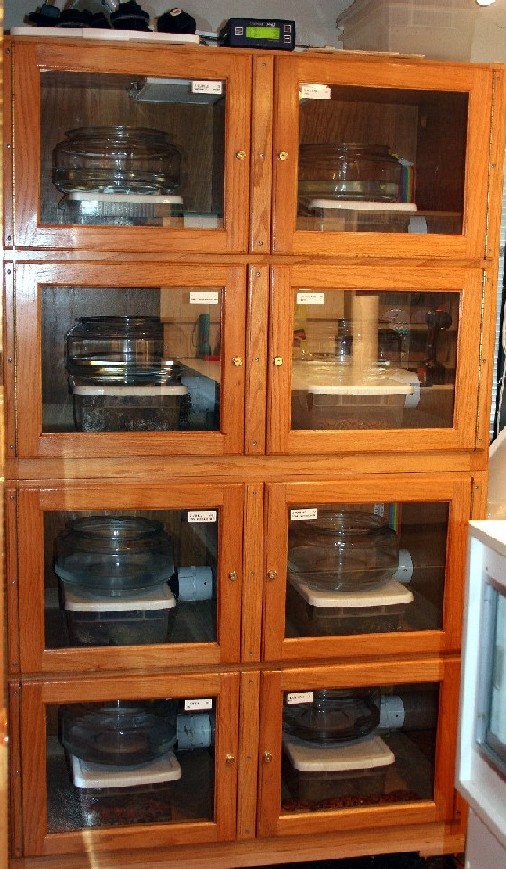

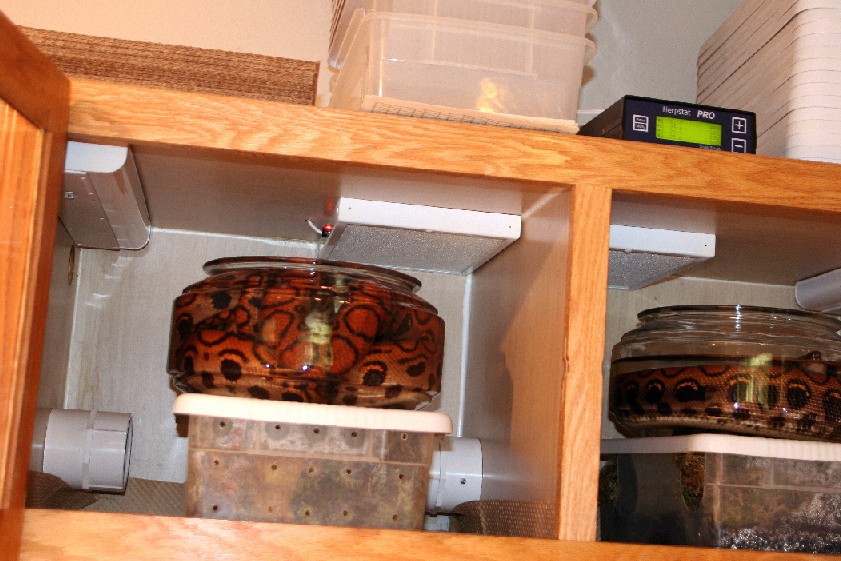
Substrate/water/hides:
I lay down two layers of newspaper followed by one layer of indented craft paper on top. Each cage gets a sweater box for hide/moss. The box gets about an inch of peat moss well dampened and another inch of green moss also nice and damp. There is also a two gallon squat water bowl with about 1 to 2 inches of water I place on top of the hide.
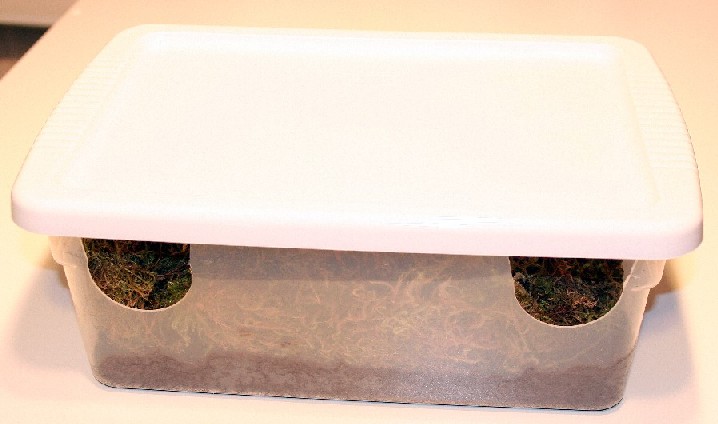
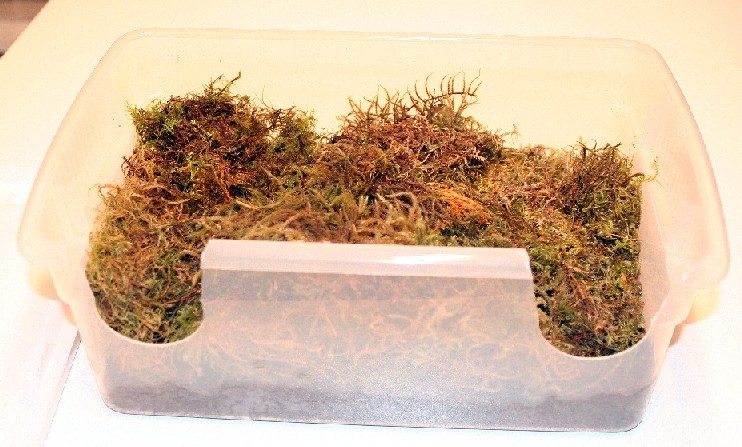
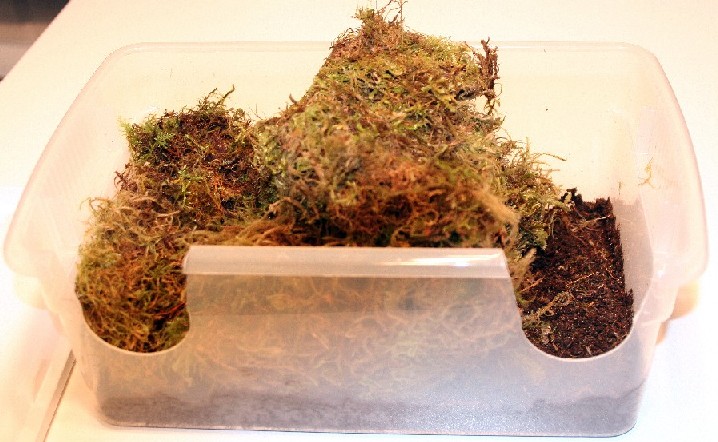
Heating:
I am using Radiant Heat Panels (RHP) to heat these cages. One RHP per section. Each level is controlled by one channel of a Herpstat Pro thermostat. Yeah, I could probably control it all with one thermostat but I want to closely control each level and not have the upper cages warmer than the lower ones. The individual channels are set to 82 degrees and with all the cages and tub racks, the whole room ends up around 75. I do use the night drop feature but only a couple of degrees. My downstairs room they occupy was built as a guest bedroom and has full insulation so the room itself retains heat very well.
Feeding/Cleaning.
I usually feed on a two week, give or take, schedule. I feed F/K as I raise my own feeders. Also sometimes feast/famine as I raise my own feeders. I usually check the cages daily and clean as necessary. More so during "eating" season. The hide boxes get checked/changed frequently as they like to poop in the moss maybe feels more natural?
Breeding cycle:
Early October I start dropping my daytime temps over a few week span from 82 to 75. Still keeping all snakes separate. (BTW, I am in San Jose CA, does not get real cold here so I have to use the middle of the winter as my cooling time) During this cooling period I also decide who is getting bred to who and arrange the females so they are in adjacent cages. I still continue feeding cleaning etc. During the entire cooling cycle.
On January first, I open the connections between cages and add in that specific male to create all my 1.2 colonies. I also start raising the temps a degree at a time over the next two - three weeks back up to 82 degrees.
Over the next several months, I block the tubes and separate the individual snakes monthly for feeding. Many females will stop eating once they are gravid but I still offer food. Two or three days after feeding, I open the tubes back up and add the male back in.
During breeding season I observe them frequently and take note of anything I notice that could be related to successful breeding:
Hemipenal sheds
Tails wrapped
Visual Copulation
Swelling in the females (possible ovulations)
Sheddings (do that year round any ways)
Laying on side or back - gravid females will do that
In May (give or take) after all breeding activity has stopped and I believe the girls are all gravid, I block off the tubes and put the males and females all back to their respective cages and tubs. This can be variable for individual 1.2 breeding trios. If both females are clearly gravid, then I can separate sooner. I feel itís better to leave them together longer than necessary then to separate them too soon!!
Due dates:
By tracking all the females sheds, I can come up with possible due dates. Add to that all my recorded breeding info and I can usually tell which shed was the POS. Typically within a month following last noted breeding activity. And typically in the March - April time frame (sometimes as late as June). I keep a spreadsheet file with formulas where I can enter in shed dates for each female and it calculates a corresponding due date. It has room for four shed dates per female so I can see alternate due dates all at the same time. I use POS plus 117 days to estimate their due dates. Once I have the necessary info and identify which shed I believe was the POS, I highlight those cells in my spreadsheet and mark my calendar!! I also put a post-it on the individual cages with that females due date.
Feeding while gravid:
Many females will not feed at all, others will sporadically and a select few will eat regularly. I figure out which ones donít typically eat and offer them food first, then keep moving the food item until itís eaten. Last time food is offered is one month prior to due date.
Birthing:
As soon as I find/notice babies I remove them from the mothers cage. Their next care depends on the state of the litter...
Babies all out cruising the cage none still attached to yolk or umbilical. I put these babies directly into shoe boxes with damp paper towels and water bowl..
Babies found shortly after (or even during) birth. Full term with minimal or no yolks and still in the egg sacks. I let the babies work them selves free of the egg sacks and umbilical then place each baby in it's shoe box with damp paper towels and water bowl.
Babies found still in sack but with yolks - best to observe and leave them alone giving them time to absorb the yolk. Once they break free, then off to their shoe box with damp towels and water bowl.
On occasion, I have transferred baby with yolk, still in sack to the shoebox. Need to keep that very clean, damp always and keep an eye on it/them. Yolk babies need to be kept extra warm (not hot) to allow them to digest that yolk and not let it harden.
Vacation:
Thought I'd mention that when I'm planning on being gone, I stop feeding two weeks prior to leaving and don't feed again until I return. This helps keep the mess to a minimum while I'm not there to clean it up. And increases the likelihood of having clean water the entire time Iím gone.
-----
Thanks,
Dave Colling

www.rainbows-r-us-reptiles.com
0.1 Wife (WC and still very fiesty)
0.2 kids (CBB, a big part of our selective breeding program)
LOL, to many snakes to list, last count (05/26/2009):
36.51 BRB
29.42 BCI
And those are only the breeders 
lots.lots.lots feeder mice and rats   
[ Show Entire Thread ]
|



